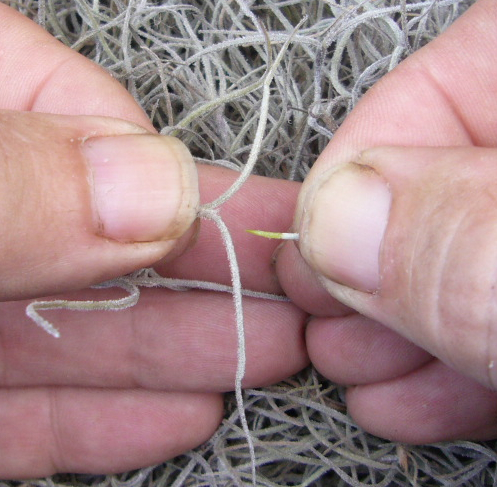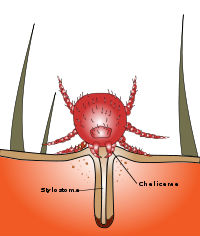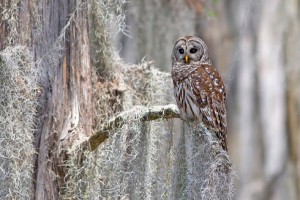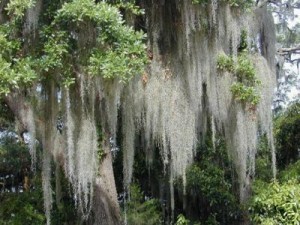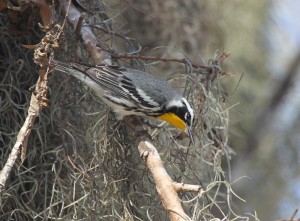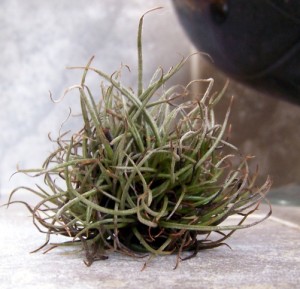Spanish Moss is not edible. Well, barely an edible. The bottom of the growing tips (pictured above) provides about one eight of an inch of almost tasteless green. It probably takes twenty or thirty calories to get that little green tip which probably only provides less than a calorie of energy. It’s really not food. It’s a “hey, watch me eat this” kind of thing, a Boy Scout nibble. But it does have uses and since I am asked about Spanish Moss all the time here’s an article about it.
First let’s talk about red bugs and chiggers, microscopic irritations said to live on Spanish Moss. They might inhabit Spanish Moss but to be utterly frank I have never gotten chiggers from Spanish Moss in trees. I have handled it and been in it many times over the decades and not once have I gotten chiggers from Spanish Moss from trees. Where I have gotten chiggers is in open fields with knee-high grass. I’ve gotten also them in knee-high brush. I have gotten them in knee-high grass and knee-high brush often enough to avoid said. But not from Spanish Moss in trees. I am not saying it’s not true. I am saying it has never happened to me. You can, however, get chiggers from Spanish Moss on the ground. When I do get chiggers I cover the wound with clear fingernail polish. Yes, it stings and but it works for me and has for over 40 years. A thick skin lotion might work as well. Treating chigger bites is a surprisingly controversial topic involving a lot of hardcore angry fanatics. Some authorities say the bug bites and hangs around thus smearing something on it is a good idea. A vote for fingernail polish. Others say nonsense, the bug bites and is gone and simple washing will do. Thus fingernail polish or any ointment is wives’ tale and nonsense. Frankly I am weary of the derogatory emails I get about it. Getting rid of the itch is what’s important and that is what I do. Now, what of Spanish Moss?
Spanish Moss — which isn’t a moss — was used to stuff car seats and furniture not only in the United States but Europe as well. It was chemically stripped of its outer gray bark and use for that purpose up until about 1960. In 1939, for example, 10,000 tons of it was raked from trees in Florida and Louisiana. It is not a parasite but an epiphyte so it doesn’t harm the tree unless it grows so prolifically to shade the tree from sunlight. Natives used it to make bedding and emergency clothes when cloth was unavailable. The inner black core was spun and used as thread. A bundle of stripped moss also makes excellent tinder. One can find them easily in local woods.
Spanish Moss is in the Pineapple family. Oral extracts of Tillandsia usneoides in a few studies have reduced blood glucose in laboratory animals. The chemical responsible is 3-hydroxy-3-methylglutaric acid. Called HMG it’s found in some diabetic supplements. Traditionally T. usneoides was brewed into a tea to treat fevers, chills, rheumatism and contraction pains of childbirth. Other claims for it include treatment of infant epilepsy, estrogen substitute, and antibacterial uses. In 2004 a Japanese company reported an extract strengthen and protects skin capillaries and slows skin cells decline. I don’t know if that is true but they took out a patent on it.
Why is it called Spanish Moss? There is an explanation but it’s on linguistic quicksand. It is said the Spanish had beards and the moss looked like their beards so it was called Spanish Moss. But… the term “Spanish Moss” seem to be rather late day innovation. As early as 300 years ago it was called Old Man’s Beard, White Beard and Spanish Beard. Detect a theme there? Other names included Florida Crape and Wool Crape. It’s found in the southern United States, the Caribbean, Hawaii and Australia, where it was introduced.
The botanical name, Tillandsia usneoides (til-LAND-sia oos-knee-OY-deeze) has an interesting background. Usneoides means “looks like usnea” which is a small, edible lichen. Tillandsia honors Erici (or Elias) Tillands, 1640-1693, a physician and professor who was extremely frightened of water. He would take a long journey on foot rather than take a short boat trip to the same destination. Linnaeus — the guy who started naming plants — was told Spanish Moss only grows in dry areas so he named it after Tilland. The irony is that in only grows in humid areas.
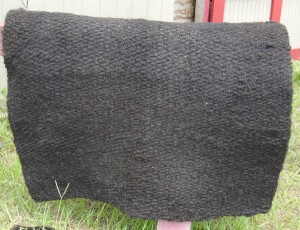
Spanish Moss Horse Blanket, at glennpierdepot
Other uses for Spanish Moss include: Lids for cooking pots, emergency blankets, insulation, mixed with clay to strengthen plaster, used to fire pots, used in tanning and to skim scum off cooking liquids, fiber woven into floor mats, to make string, rope and sacks, fire arrows to destroy invaders’ forts, doll decorations and Voodoo doll stuffing. It can be soaked — a natural sponge — and used as a covering to keep things from drying too fast, such as dug out canoes and cement. It also makes excellent mulch and the water it is boiled in is excellent fertilizer. Spanish Moss is often draped on chain link fences to create privacy. To easily clean the bark off the fiber soak the Spanish Moss in water for six weeks. Or, you can throw it into a pile for about six months where it will rot naturally. A third option is to rub Spanish Moss with Spanish Moss to get rid of the coating.
Birds like to nest in it, particularly Warblers and the Baltimore Oriole. Rat Snakes and at least three bats call it home. Some livestock will eat Spanish Moss. One jumping spider, Pelegrina tillandsiae, is found only on Spanish Moss. Jumping spiders, by the way, are bight little creatures with at least two large eyes out of the eight. They are hunters, colorful, and often kept as pets. I used to feed one using tweezers and blind deceased mosquitoes.
There is also Ball Moss. Tillandsia recurvata, right, is similar to Spanish moss except it is compact and has larger growth, which also makes it easier to get an edible nibble. It blooms in the spring with a blue-violet flower and tends to be about the size of a baseball but can be smaller or much larger. Sensitive to freezing Ball Moss can be found from the southern United States to Argentina and Chili. Medicinally an extract has shown the ability to cause death of tumor cells.
Green Deane’s “Itemizing” Plant Profile: Spanish Moss
IDENTIFICATION: Tillandsia usneoides: Spanish-moss is a fibrous, perennial, epiphytic herb. It hangs from trees in long, thick masses that may reach 20′ in length. The leaves are grayish-green, narrowly linear, and up to two inches long. It looks like filaments with many branches and is covered with silvery-gray scales. The flowers are tiny with pale greenish-blue blossoms. They form in the axils of the leaves and may give off a light fragrance at night. Te flowers lead to tiny capsules which split open to release even smaller seeds.
TIME OF YEAR: Year round
ENVIRONMENT: Spanish Moss grows well in full sun but endures partial shade. It prefers moist environments 50 to 90ºF but can survive well in dry habitats too. Spanish Moss is usually found on oaks or cypress trees — it likes the chemicals that leach form the trees’ bark — but can be found on other species such as pine or sweet gum.
METHOD OF PREPARATION: Growing tips are pulled out of their sheath. The tiny green tip can be eaten raw.
Lyrics to Spanish Moss by Gordon Lightfoot
SPANISH MOSS
Let go darlin’
I can feel the night wind call
Guess I’d better go
I like you more than half as much
As I love your Spanish moss
Spanish moss hangin’ down
Lofty as the southern love we’ve found
Spanish moss
Keeps on followin’ my thoughts around
Georgia pine and Ripple wine
Memories of Savannah summertime
Spanish moss
Wish you knew what I was sayin’
So I’m rollin’ north thinkin’
Of the way things might have been
If she and I could have changed it all somehow
Spanish moss hangin’ down
Lofty as the sycamore you’ve found
Spanish moss
Keeps on followin’ my thoughts around
Georgia pine and Ripple wine
Kisses mixed with moonshine and red clay
Spanish moss
Wish you knew what I was sayin’
So I’m rollin’ north thinkin’
Of the way things might have been
If she and I could have changed it all somehow
Let go darlin’
I can feel the night wind call
The devil take the cost
I like the way your kisses flow and I love your Spanish moss

